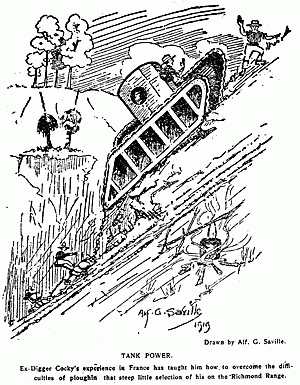1918: Australians in France - Tanks (Landships)
It would be impossible to discuss the warfare of 1918 without mentioning the immense impact of "landships" or tanks. The evolution of their use was a long process. In the earlier years of the war, there was some doubt as to their effectiveness and worth. There is some debate about the origin of the word "tank". However, it is commonly accepted that it derived from the term "water carrier" - the innocent name tanks were initially given to divert any enemy attention from this new war project. The very first tank prototypes were developed in secret trials in late 1915 and early 1916. The tank which resulted from the trials, the 'Mark I', was used in battle for the first time at Flers-Courcelette on the Somme battlefield on 15 September 1916. .
Initially, commanders and men found it difficult to adjust to these bulky monsters with their cumbersome design. However, tanks gradually gained respect as tactical weapons. They provided greater mobility and cover for infantry on the battlefield, and they could be used as carriers for supplies. By September 1916, 49 tanks were in use on the Somme. They were also used in Palestine from 1917.
At the battle of Cambrai in 1917, the further developed Mark IV tanks were said to have been the decisive factor in the Allied victory. By 1918, many battles such as Hamel and the Battle of Amiens were planned with Mark V tanks as an integral part of the operation.
The Mark V tank was a great improvement on its predecessors. It had a powerful purpose-built engine, as well as a new steering mechanism. It was more reliable, mobile and easier to control. Crews had also improved: they were now better trained and more experienced.
Over 500 tanks were used in the British-Canadian-Australian attack at the Battle of Amiens. Most were armed with 6-pounder guns or machine-guns. Lightweight "Whippets" and special troop-, supply- and gun-carrying tanks were also used.
Major General John Monash was one of the main supporters of tanks and their potential in 1918. Since earlier models had proven ineffective in previous battles, many Australian soldiers were reluctant to try them again. To Monash's credit, he did, and he was rewarded. Tanks were used in a variety of roles: to protect infantry, to attack and fire on the enemy front line, to cut through wire entanglements, and to carry ammunition and supplies. At the battle of Hamel, for example, four tanks took forward loads that would have required 1,250 men to carry.

A 1919 cartoon from the AIF publication Aussie, illustrating Australian soldiers' fondness for tanks by the end of the war.
A German tank captured at Villers-Bretonneux by the 26th Australian Battalion near Monument Wood, 14 July 1918.


